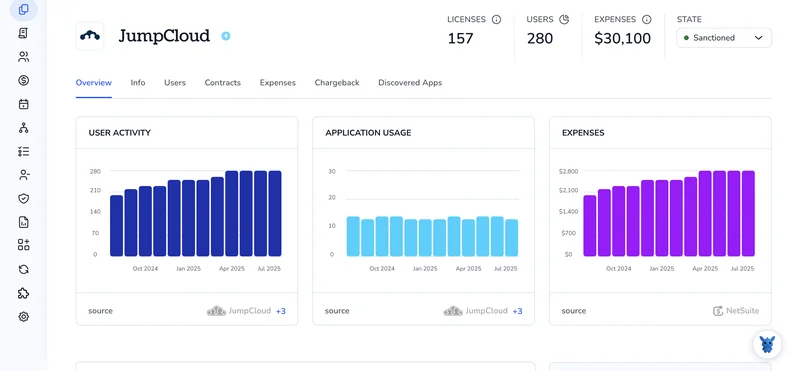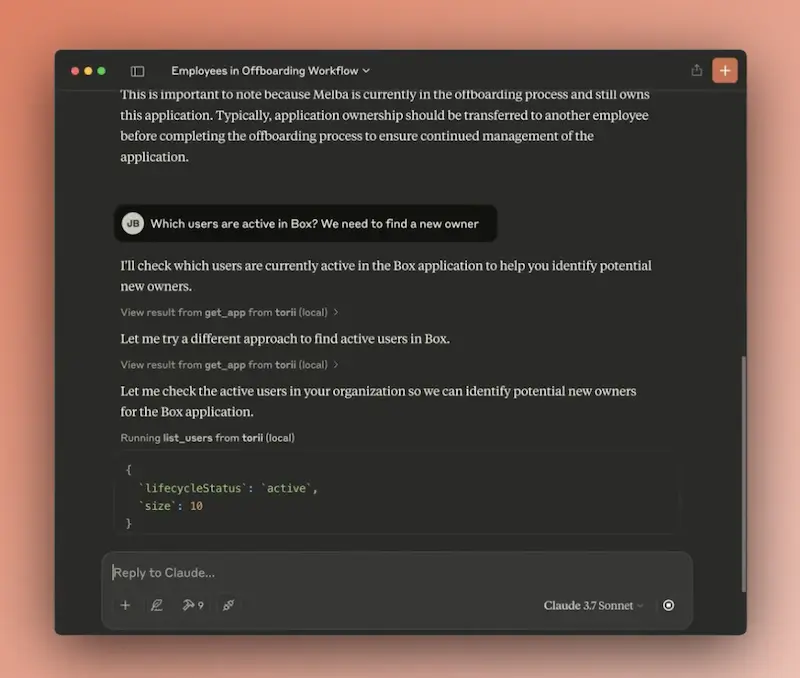4 Ways to Access Contract Details for Your JumpCloud Account

When auditors knock or budgets get reviewed, the first thing everyone asks for is the contract. Digging through emails or old DocuSign links wastes time and raises stress.
JumpCloud stores every agreement in a few spots you might not check daily. Below, you’ll see four quick paths to pull terms, renewal dates, and contacts whenever you need them.
Table of Contents
Use JumpCloud’s UI
You’ll use the JumpCloud Admin Portal to pull up the fine print: plan name, renewal date, and anything else tied to your subscription.
1. Sign in to the Admin Portal
- Head to admin.jumpcloud.com and enter your admin credentials.
- The console loads on the Dashboards view.
2. Open the Organization Details window
- Look in the top-right corner for the round avatar (it shows your initials if no photo is set).
- Click the avatar, then choose Organization Details.
JumpCloud’s help article “View your organization details” confirms this path.
3. Review the Subscription block
-
A pop-up appears. Scan for the section labeled Subscription.
-
You’ll see:
- Subscription ID
- Plan or edition (e.g., Business, MSP)
- Contract start and renewal dates
- Account manager contact info
- Copy anything you need for audits or renewals.
4. Check license counts and seats (optional but handy)
- Close the pop-up.
- In the left navigation, click Billing, then Plan.
The page lists the number of paid user seats, add-ons, and current usage. This mirrors the guidance in JumpCloud’s “Manage your subscription” doc.
5. Download invoices if you need proof of purchase
- Still in Billing, switch to Invoices.
- Pick the PDF icon next to any month to grab a copy for finance.
You’re done. All contract details are now at your fingertips, with no API calls or support tickets required.
Use Torii
Instead of logging into JumpCloud for contract details, pull them through Torii, a SaaS management platform that gathers every subscription in one view.
Torii shows each app’s licenses, costs, and renewal dates, so finance and IT stay on the same page.
1. Sign up for Torii
Contact Torii for a free two-week proof of concept and see how quickly live data appears.
2. Connect your expense accounts & contracts to Torii
Once your Torii environment is active, connect your finance tools, such as Coupa, QuickBooks, or another system, so JumpCloud spending syncs automatically.
You can also upload contracts directly to Torii, and its AI will pull out pricing and terms for you.
Here are more instructions for the JumpCloud integration.
3. Search for JumpCloud within Torii
Open the Torii dashboard and type “JumpCloud” into the search bar. The resulting app page lists license counts, total spend, renewal dates, and other key details your team needs.

Or, chat with Eko
Torii’s AI assistant, Eko, surfaces JumpCloud details without leaving the platform. Click the Eko icon in the dashboard’s lower-right corner, ask for the data, and the answer lands immediately in the chat window.

Use JumpCloud’s API
Here’s how to grab your JumpCloud contract, seat, and renewal info straight from the platform’s REST API. No console clicks needed.
1. Get an API key that can read org data
Your JumpCloud administrator token must include the platform_management permission set. Copy it somewhere safe; you’ll pass it in every call to the API by including the header x-api-key.
2. Find (or confirm) your Organization ID
If you don’t already know the Org ID, ask the API for it with one quick curl command:
curl -X GET \
https://console.jumpcloud.com/api/organizations \
-H 'x-api-key: YOUR_API_KEY' \
-H 'Accept: application/json'
The response array will list each org the key can see. Note the id value you want.
3. Call the subscription endpoint
JumpCloud keeps all contract data on the organization record, and you can retrieve it with a single call:
curl -X GET \
https://console.jumpcloud.com/api/organizations/ORG_ID \
-H 'x-api-key: YOUR_API_KEY' \
-H 'Accept: application/json'
Look for the subscriptionInfo (sometimes returned as subscription_information) object in the JSON. A trimmed response might show:
{
"id": "5f123456789abcd123ef01",
"name": "Acme Inc",
"subscriptionInfo": {
"planName": "Core",
"seatsPurchased": 150,
"seatsUsed": 126,
"status": "active",
"renewalDate": "2024-05-12"
}
}
Key fields:
planName– The contract tier.seatsPurchased– Seats you’re paying for.seatsUsed– Seats now consumed.renewalDate– When the contract rolls over.status– active, trial, or suspended.
4. Filter or export what you need
For quick terminal reads, pipe the call through jq to isolate just the fields you care about:
curl -s -H 'x-api-key: YOUR_API_KEY' \
https://console.jumpcloud.com/api/organizations/ORG_ID \
jq '.subscriptionInfo {planName, seatsPurchased, seatsUsed, renewalDate}'
Drop it into a script or a scheduled job, and you’ll spot usage drift well before renewal.
Use Claude (via MCP)
If you’d prefer, you can pull these details right inside Claude by turning on the Model Context Protocol (MCP). Claude is Anthropic’s chat assistant and works much like ChatGPT.
To surface JumpCloud contract information through Claude, follow the steps below in the order they appear:
1. Configure Torii
Use the earlier Torii instructions to connect your JumpCloud workspace to Torii and confirm that the link is active.
Once connected, head to Settings, choose API keys, and generate a fresh token for this integration.
2. Enable MCP inside Claude
Refer to the official Torii MCP guide, and scan the supporting blog article, before moving forward.
Download the Claude Desktop client, then insert the following snippet into claude_desktop_config.json:
{
"mcpServers": {
"Torii MCP": {
"command": "env",
"args": [
"TORII_API_KEY=YOUR_API_KEY",
"npx",
"@toriihq/torii-mcp"
]
}
}
}
(The API key you just created in Torii’s Settings should replace the placeholder text labeled YOUR_API_KEY inside the file.)
3. Start conversing with Claude
At this point you can talk to Claude as though it were your Torii dashboard. Need to know how many JumpCloud licenses are active? Claude will also share current spend and the renewal date, all without requiring you to leave the chat.

Torii for SaaS Management
Ready to take full control of the software scattered across your company? Let us know, because Torii’s SaaS Management Platform lets you:
- Uncover shadow apps: Smart AI scans your environment in real time and flags unsanctioned tools.
- Reduce spend: Eliminate idle licenses and overlapping software to trim waste.
- Automate onboarding and offboarding: Hands-off user lifecycle workflows save hours and cut mistakes.
- Never miss a renewal: Receive alerts before contracts come up for renewal so nothing slips.
Torii gives Finance, IT, and Security teams a single, reliable source of truth for every app in use.
For a closer look at the platform and its features, visit Torii.
Frequently Asked Questions
Use the Admin Portal: avatar › Organization Details › Subscription; optionally Billing › Plan. Or integrate JumpCloud with Torii, call the /organizations endpoint, or chat via Claude MCP. Each route lists plan, seats, contacts, and renewal dates.
In the Admin Portal, click your avatar, choose "Organization Details," then scan the Subscription block. The renewal date also appears on Torii’s JumpCloud page and in the subscriptionInfo field returned by the API, so you’ll never miss an upcoming rollover.
Yes. Create an admin API token with platform_management rights, retrieve your Org ID, and send GET /organizations/ORG_ID with x-api-key. Pipe the JSON through jq or scripts to export planName, seatsPurchased, seatsUsed, status, and renewalDate for reporting.
Torii aggregates JumpCloud invoices, license counts, and renewal dates alongside every SaaS bill. Finance gains a single dashboard to view spend, set renewal alerts, identify idle seats, and eliminate overlaps—no manual spreadsheets or separate JumpCloud logins required.
The object includes planName, seatsPurchased, seatsUsed, renewalDate, and status. Together these fields show contract tier, purchased versus used seats, when the agreement renews, and whether the subscription is active, trial, or suspended.
Yes. After connecting JumpCloud to Torii and generating an API key, enable Torii MCP in Claude’s desktop settings. Claude can then answer chat queries about JumpCloud seats, spend, or renewal dates without opening the JumpCloud console or Torii.

